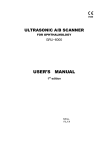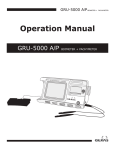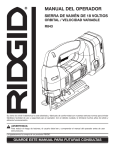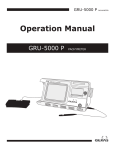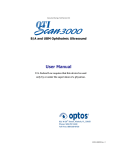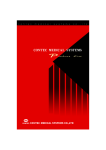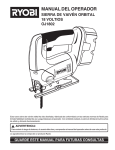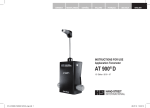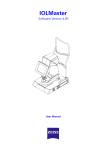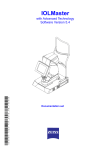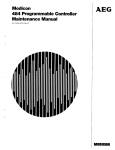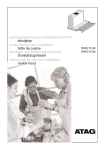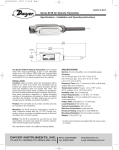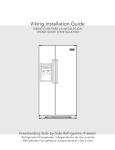Download USER`S MANUAL
Transcript
ODM-2100S ULTRASONIC A/B SCANNER FOR OPHTHALMOLOGY USER’S MANUAL Version 4.1 User's Manual 0 Contents PRECAUTIONS................................................................................................................................................... i WARNINGS........................................................................................................................................................ i CAUTION.......................................................................................................................................................... ii Labels and Indicators....................................................................................................................................... 1 Chapter 1. Introduction....................................................................................................................................2 1.1 General Description.......................................................................................................................... 2 1.2 Intended Use.....................................................................................................................................2 1.3 Contraindications.............................................................................................................................. 2 Chapter 2. Specifications..................................................................................................................................3 2.1 Working Conditions...........................................................................................................................3 2.2 B Mode..............................................................................................................................................3 2.3 A Mode..............................................................................................................................................3 2.4 Firmware........................................................................................................................................... 4 2.5 Safety................................................................................................................................................ 4 2.6 Storage and Transportation.............................................................................................................. 4 Chapter 3. Installation, Startup, Shutdown......................................................................................................5 3.1 Packing List........................................................................................................................................5 3.3 Environmental Requirements........................................................................................................... 5 3.4 Connection........................................................................................................................................6 3.5 Environmental Protection................................................................................................................. 7 3.6 Startup Procedure.............................................................................................................................7 3.7 Shutdown Procedure........................................................................................................................ 7 Chapter 4. Operation....................................................................................................................................... 8 4.1 Keypad Description........................................................................................................................... 8 4.2 Suggested Position of Patient, Operator and other near person....................................................10 4.3 B Mode............................................................................................................................................10 4.4 A Mode........................................................................................................................................... 14 4.5 Five-Point Marking Method............................................................................................................ 16 4.6 IOL Calculation................................................................................................................................ 19 4.7 Parameter Setup............................................................................................................................. 21 4.8 Image printing.................................................................................................................................22 Chapter 5. Cleaning, Disinfection and Sterilization........................................................................................23 5.1 How to prevent Cross-Infection...................................................................................................... 23 5.2 Sterilization Procedure – Pre-sterilization and Sterilization of the Probes..................................... 23 5.3 Preparation of Sterilization agent................................................................................................... 24 5.4 Standard method............................................................................................................................ 25 5.5 Method for high risk patients......................................................................................................... 28 Chapter 6. Maintenance and Trouble Shooting............................................................................................. 31 6.1 Maintenance of the Device.............................................................................................................31 6.2 Biometric Test................................................................................................................................. 31 6.3 Trouble Shooting.............................................................................................................................32 Chapter 7. Service and Support Information................................................................................................. 34 7.1 Warranty......................................................................................................................................... 34 7.2 Accessories and Consumables........................................................................................................ 34 Annex A Acoustic Output Information...........................................................................................................35 Annex B Guidance and manufacturer's declaration..................................................................................... 37 Annex C References....................................................................................................................................... 41 User's Manual 1 Precautions and Warnings PRECAUTIONS � The instrument should be operated by trained doctors. � Please read the manual carefully before installation and operation � Please refer to chapter 5. Cleaning, Disinfection and Sterilization to avoid cross-infection while using. � Unplug power supply before cleaning. � Please refer to chapter 6. for maintenance attentions. WARNINGS � Do not make any modification to the Device without authorization. � The manufacturer won't be responsible for any damage or injury caused by any failure to follow the instructions in the User's Manual Manual. � The manufacturer reserves the right to modify equipment characteristics without previous notice under FDA Laws and MDD (93/42/EEC) Regulation. � The quality guarantee of ODM-2100S will be invalid if it is opened (even partially), modified or repaired in any way by anyone who is not authorized by the manufacturer. ____________________ � This device is not intended for fetal use. � According to FDA laws, ODM-1000 is a prescription Device and is to be used by or under the supervision of a licensed physician. � Disconnect AC power before cleaning the housing case. � While plugging in the robe, make sure the red mark on the probe align with the red mark on the socket. � While plugging of the probe, please be sure you are pulling the connector instead of the cable. � Do not scratch the surface of the probe. � Do not drop the probes For any question, please contact the Manufacturer or your Local Distributor User's Manual i Precautions and Warnings CAUTION HOW TO PREVENT CROSS-INFECTION � Between uses on different patients the probe must be cleaned to prevent cross-infection. � Manufacturer advocates a preventive action and a cleaning procedure in Chapter 5. Cleaning, Disinfection and Sterilization. ____________________ CAUTION � The ODM-2100S IOL calculator will calculate negative IOL values if such is predicted by the data input. � These are displayed with a minus sign "-". Do not ignore this sign. CAUTION � To preserve the equipment, avoid using any abrasive cleaner. If possible, clean spots before they dry. _____________________ TISSUE EXPOSURE TO ULTRASOUND ENERGY: � The ODM-2100S is designed for use in ophthalmology only. � While the manufacturer is not aware of any reports of adverse effects from using ophthalmic ultrasound scanner, even at FDA pre-enactment levels, no other use is intended or implied. � The system controls limit of the output energy within the parameters specified for its intended purpose. Please refer to Annex A of User's Manual Manual. � No control of ultrasound energy is available to the users other than the duration of exposure, considering the current concern for possible unknown hazards, and despite the extremely low output intensities used in this ultrasound system. � The manufacturer recommends that patients exposure time during measurement. User's Manual ii Labels and Indicators Labels and Indicators A-Probe Socket B-Probe Socket POWER IN AC 100V-240V Power Input, 50/60Hz │ Power On 〇 Power Off FUSE FOOTSWITCH VIDEO OUT GAIN Fuse Socket, 100V-200V:4A 200V-240V:2A Footswitch socket Video Signal Output Gain Control Contrast Control Brightness Control Symbol of "Type B" Refer to User's Manual Equipotentiality CE mark IPX7 The degree of protection against ingress of liquids Note: only for SONY/MITSUBISHI Video Printer. User's Manual 1 Chapter 1. Introduction Chapter 1. Introduction 1.1 General Description ODM-2100S Ultrasonic A/B Scanner for Ophthalmology is an ultrasonic imaging instrument specialized in ophthalmological diagnosis. It consists of the main unit, 10MHz mechanical sector B-scan probe, 10MHz A-biometric probe, built-in video monitor, and foldable keypad. 1.2 Intended Use The device is intended to be used for ophthalmic ultrasonic diagnosis and measurement. 1.3 Contraindications Eyelid trauma and severe eye infection patients are prohibited to use B scan and cornea trauma, inflammation or infection patients are prohibited to use A-biometric Scan. User's Manual 2 Chapter 2. Specifications Chapter 2. Specifications 2.1 Working Conditions Environmental temperature: 5°C~40°C, relative humidity: ≤ 80%. Power supply: AC 100V~240V,50/60 Hz 2.2 B Mode � Ultrasonic frequency: 10MHz. � Scanning method: mechanical sector scan. � Gain control: � Display mode: B, B+B, B+A. � Gray scale: 256 � Scanning scope: depth 31mm-63mm, scanning angle: 53º. � Resolution: axial � Accuracy of geometrical position: axial � Capacity of digital scan converter (DSC): ≥4 ×512×512×8 bit � Electronic caliper: electronic cursor for distance measurement, � Accuracy: 0.25mm. 98dB. 0.2mm, lateral 0.4mm 5%, lateral 10% 2.3 A Mode � Ultrasonic frequency: 10MHz. � Biometry accuracy: � Resolution: 0.01mm. � Measuring range (AL): 15-39mm. � Total gain: 98dB, user adjustable gain range: 0-55dB. � Measuring parameter: anterior chamber depth, lens thickness, vitreous length and axial length. � Measuring method: automatic and manual � IOL power calculation: SRK-1, SRK/T, SRK-II, BINK/2, HOLLADAY and HOFFER-Q. User's Manual 0.06mm. 3 Chapter 2. Specifications 2.4 Firmware Firmware: 21SAB V1.20 2.5 Safety In accordance to IEC 60601-1 and IEC 60601-2-37 2.6 Storage and Transportation Storage Condition: Packed device should be stored in a room of Temperature: -20℃~40℃; Relative humidity: ≤80%; No corrosive gas, well-ventilated. Transportation: The accessories such as Probe should be packed in to original package before transportation. Severe impact and crash, rain and snow shall be avoided. User's Manual 4 Chapter 3. Installation, Startup, Shutdown Chapter 3. Installation, Startup, Shutdown 3.1 Packing List Please check the components in the package according to the following list. � Main Unit 1 � B Probe 1 � A Probe 1 � Foot Switch 1 � Power cord 1 � Fuse 2 (110V-120V: 4A; or 220V-240V:2A) � Test Object 1 � User’s Manual 1 3.2 Main Parts of ODM-2100S ODM-2100S consists of Main Unit, 10 MHz mechanical sector B Probe, 10 MHz A mode biometric probe, built-in video monitor and foldable keypad. Its configuration is as below: Fig 3-1 3.3 Environmental Requirements The device should be operated in clean, dry and air-conditioned environment. The power socket used must be with good grounding, otherwise it increases the risk of noise as well as creepage. � Do not use the equipment in locations subject to intense electric or magnetic fields. Avoid excessive shock (e.g. tooth drill) and direct sunlight. User's Manual 5 Chapter 3. Installation, Startup, Shutdown The equipment should be placed on a stable worktable. Leave certain space around the instrument and avoid soft object below it for ventilation. 3.4 Connection Fig 3-2 1) Plug footswitch cable to FOOT SWITCH socket on the rear panel. 2) Plug power cable to the power socket on the rear panel and the other end to a properly grounded power supply socket. 3) Plug B probe into B-Probe socket on the right panel. 4) Plug A probe into A-Probe socket on the right panel. Note: 1) While plugging the probe, make sure the red mark on the probe aligns with the red mark on the socket. 2) The probe should be placed in the probe holder. Do not put it on table or other supporters. Do not scratch the surface of the probe. 3) While unplugging the probe, please hold the connector. Do not pull the cable. 4) If the probe drops while using or moving, please check the surface and shell carefully. If any of them is broken, then stop using it immediately and contact the manufacturer or local distributor for repairing. 5) If a video printer is available, connect the video cable to VIDEO IN of the printer, and the other end to User's Manual VIDEO OUT on the rear panel of the main unit. 6 Chapter 3. Installation, Startup, Shutdown 3.5 Environmental Protection When the device is abandoned, it could be treated as usual Electronic products according to the local Regulation. And its package should be treated as the plastic and paper materials according to the local laws. The gel bottle is made of polythene, and the remaining gel is water-soluble. Heavy metal contents meet the requirements of cosmetic standard. The treatment of the empty bottle should conform to the local environmental protection regulations. It can be treated together with disposable plastics such as syringe 3.6 Startup Procedure 1. Check up all the connections including power cables, Probes. If not connected, please connect them under the instruction of 3.4 Connection Connection. And keep the probes in the probe holder. 2. Start the Power socket, and then switch on the power switch on the rear panel of main unit. 3. A few minutes later, you could see the single B mode interface on the screen, and now it could start diagnosis. 3.7 Shutdown Procedure 1. Make sure all the diagnosis result and data have been printed or transferred to your workstation or computer. 2. Put two probes back to the probe holder. 3. Turn off the switch of main unit. 4. Shutdown all the devices connected with ODM-2100S (Such as printer, workstation). 5. Shutdown the power socket connected with ODM-2100S. User's Manual 7 Chapter 4. Operation Chapter 4. Operation 4.1 Keypad Description The instrument can be operated by keypad and soft keys on the screen. The keypad consists of alphabetic keys, numeric keys and functional keys. The soft keys are controlled by the trackball and its left and right key L and R . 4.1.1 Alphanumerical keys Letter, Number Number:: The alphabetic and numeric keys are used to input characters in the place of the cursor. �, �, �, � Press them to input corresponding arrows in the place of the cursor. � Backspace key. Press it to place the cursor one space back. At the same time the character will be erased. SPACE Space key. To move the cursor to the right. Enter key. It is used to finish the current line and go to the next line, or finish the ↵ current item and go to the next one. + - To adjust the threshold of A-Scan measurement under A-Mode; while under the interface of IOL and SETUP, can be used as just plus and minus. 4.1.2 Function Keys B Press it to enter single B scan. B+A Press it to enter B+ A mode. B1 B2 A Press them to enter double B scans and switch between images of B1 and B2. Press it to enter A mode automatic measurement or to refresh A-scanning and start a new measurement. AUTO Automatic measuring key. Press it in the status of A automatic measurement, the instrument will be shifted among NORM, APHA, SPEC and CATA. User's Manual 8 Chapter 4. Operation � NORM NORM: NORMAL EYES � SPEC SPEC: SPECIAL EYES � APHA APHA: APHAKIC EYES � CATA CATA: DENSE CATARACT EYES MANL Manual measuring key. Press it to enter manual measurement of A mode. IOL Press it to enter IOL calculation mode where calculation parameters can be input. From A-Mode to IOL, the average axial length can be automatically put in AL box; while if an appointed AL from 8 groups of results is necessary, press AL. Refer to AL below. AL Press it under IOL mode, the axial length pointed by “→” line that is measured automatically in A mode can be input to AL box for IOL calculation. CAL In IOL mode, press this key to calculate IOL after all constants are input correctly. OS OD Indicate left or right eye which is displayed on the screen. � � � Cursor control / function keys used to move the cursor and select functions. � � � In B mode, press it to turn the image page up and down and save 8 pages, marked as P1-P8; in A mode, press it to display the curve of automatic measurement indicated by “→”; In IOL mode, press it to retrieve the information of axial length, cornea curvature, etc. FRZ/SCN Scan/Freeze control key. Press it, the instrument shifts from START SCAN to FREEZE IMAGE or from FREEZE IMAGE to START SCAN SCAN. After 10 minutes of scanning, it is frozen automatically to protect the probe. 4.1.3 Trackball The trackball can be used to move the cursor on the screen. Press functions where the cursor is; In B mode, press R L to activate the to display or hide the functional menu on the right side of the screen. 4.1.4 Gain Control Knob In B mode or A mode, the gain can be changed by adjusting this knob. Change of gain is displayed on the screen at the same time: GN = xx dB. 4.1.5 Foot switch User's Manual 9 Chapter 4. Operation In B mode or A mode, the foot switch has the same function as the start-up of the probe. When it is started, SCN FRZ/SCN , i.e., controls is on the screen: in B mode, the probe waves and the image is displayed dynamically; in A mode, the probe indicator is on. When it is frozen, FRZ is on the screen: in B mode, the probe stops and the image is still; in A mode, the probe indicator is off. 4.2 Suggested Position of Patient, Operator and other near person. In a usual measurement, it's better to let patient lie down and let his head close to the device (less than 1.2m). The operator should take a position convenient for reach patient's head and operating the device. 4.3 B Mode Fig 4-1 In mode menu, SB: single B mode; B1/B2: double B images; B+A/A+B: B mode and A mode, both B image and A waves displayed. Click the functional keys or the L key of the trackball to enter the corresponding work mode. The screen displays as following (Fig 4-2): User's Manual 10 Chapter 4. Operation Fig 4-3 Single B Mode Fig 4-4 Double B Mode The upper one is B1 and the lower one is B2. Select one of them and active it, then you can scan, freeze, adjust the gain, label the eye and save. Press the ↑ ↓ keys to move the Sample taking Line and A curve changes accordingly . Fig 4-5: B+A Mode 4.3.1 Direction and Position Analysis There is a white dot on one side of the probe end. This dot always corresponds to the upper part of the sector image. For instance, if the dot is above the eye, marked as “↑”, the image on the screen is the vertical section of that eye. The top of the sector corresponds to the upper part of the eye, and the bottom of the sector corresponds to the lower part of the eye. Another example: if the dot Fig 4-6 is on the nose side of the right eye, marked as “→”, the image on the screen is the horizontal section of the eye. The top of the sector is the nose side of the eye, and the bottom of the sector is the temporal side of the eye. User's Manual 11 Chapter 4. Operation Move the cursor with the trackball to the probe position marker, press L key, the marker will rotate clockwise; it rotates 45° every time it is pressed. 4.3.2 How to obtain a scan under B mode. a) Select B mode. b) Input patient information at the bottom of the screen. Fig 4-7 c) � NAME: 13 digits of letters or numbers. � SEX: 6 digits of letters or numbers. � AGE: 3 digits of letters or numbers. Label the eye to be examined. Press OD key for right eye; press OS key for left eye. d) Let the patient lie on his/her back, slightly close the eyes. e) Put some acoustic gel on eyelid; gently place the B probe on the eyelid. f) Push down the footswitch or press FRZ/SCN , the probe starts scanning. The real time ultrasonic sectional view of the eye will appear on the screen. g) Adjust the total gain knob to make the focus clear and get a satisfactory image. Push down the footswitch again or press FRZ/SCN to freeze the image. The collection of ultrasonic B image is completed. Note: Adjustment of gain control is one of the key operations that affecting B mode image quality. For different conditions and diagnostic requirements, the gain adjustment is different. Make sure do not fix the gain, however it is also not the case that the larger the gain, the better the image. h) Press the � � keys to save the current image and turn the page up and down. Mark the image with P1 ,…, P8 . 8 images can be saved at most 4.3.3 Function Menu In B mode, press the R key of the trackball to show the functional menu; press any key again to hide it. Select the functions with the trackball’s User's Manual L key. 12 Chapter 4. Operation a) ZOOM Depth control key. To change the scanning scope. 6 depths are available to be adjusted. They are showed on the right upper screen as: Press � DEPTH = 34 mm � DEPTH = 50 mm � DEPTH = 39 mm � DEPTH = 56 mm � DEPTH = 45 mm � DEPTH = 60 mm ← b) PROC → to adjust the depth. It is effective after the scanning is activated. Gray scale control and Post-image processing key. Press ← → keys to select the post image processing mode: linear (LINE), logarithmic (LOG CURVE), exponential (EXP CURVE) and S (S CURVE). c) TEXT Full screen text labeling key. Move the cursor with the L key of the trackball and enter the text to label the image. d) DIST Distance Measuring key. Select DIST and activate double cursor distance measuring status, a “++” appears on the screen. Move the “++” to the position where you want to start measuring, then press the L key of the trackball, the current “++” will be locked. Move the trackball again, another “++” is shown up. Move it to the terminal of measuring and press L key again to complete the measurement. The distance between two “++” will appear on the screen. The unit is “mm”. If another measurement is needed, repeat the above procedure. e) AREA L Area measuring key. Press of an area with the trackball. Press L key to fix a start point and draw the outline key again to get the area measurement result. Multiple measurements can be made and the unit is mm2. f) CLRS g) NEW To clear all the labels and measuring results on the image. New patient. Clear the previous patient’s information, temporarily save ultrasonic B images and get prepared for the next examination. h) EXIT User's Manual To exit function menu. 13 Chapter 4. Operation 4.4 A Mode Ultrasonic A Biometry is used to measure the anterior chamber depth, lens thickness, vitreous length and to calculate the axial length according to these measurements. To ensure the accuracy, the ultrasound should go into the eye from the vertex of the cornea as close as possible, and superpose with the axis. Auto and manual modes can be selected for the measurement. Auto mode is suitable for normal, aphakic, dense cataract and other conditions, where the velocity of ultrasound is known. For contact method, A probe is contacted with the cornea vertex directly. This method is simple and easy to control. But the cornea can be injured and slightly distorted, therefore affecting the results. So the operator should operate very carefully and not press the cornea. The contact method applies to both the auto and manual mode. When A Scan is selected, it enters the following screen (Fig 4-8). Fig 4-8 � NORM Normal Eye, Auto � AC Anterior Chamber Depth � APHA Aphakic, Auto � LENS Thickness of Lens � SPEC Special Eye, Auto � VITR Vitreous Length � CATA Dense Cataract, Auto � AL Axial Length � MANL Manual � AV Average Measuring Result � COR Thickness of Cornea � SD Standard Deviation 4.4.1 Auto Measuring User's Manual 14 Chapter 4. Operation (1) Press A to enter A scan auto measuring mode (NORM). (2) Select the type of eye among NORM, APHA, SPEC, CATA. (3) Let the patient lie on his/her back and open both eyes. Anaesthetize the eye to be measured. (4) Sterilize the front part of A probe with chloramphenicol eyedrop. (5) Push down the footswitch or press the � FRZ/SCN to start scanning. Let the patient stare at the probe and put the probe on the cornea vertex gently. (6) Adjust the gain control to get the satisfactory wave. (7) When you hear a series of beep sound, the result comes out and is displayed on the screen. If the beeps are not heard, move the probe slightly until beeps heard and the measuring is completed. Measuring is undertaken one by one automatically until eight groups of data are achieved or it can be stopped when FRZ/SCN is pressed to freeze the image. Eight groups of data can be achieved from each patient at most, and the operator decides how many groups of data are needed. Note: Since auto measuring result is calculated by averaging multiple operations, the operator needs to handle the probe gently and stably. The image can be frozen and the probe be taken away only after the beeps stop and the result appears on the screen. Check the results & Delete unreliable data: If the measuring results are obviously unreliable, delete them. Press � � keys to move the cursor “→”” to the line that needs to be deleted and click DEL with the trackball’s L key. The next line moves up and average value is recalculated. Fig 4-8 A waveform with contact method Please delete the results in the following situations: User's Manual 15 Chapter 4. Operation � Position marker does not correspond with the top of the wave. � The retina wave is not sharp. � There is a big difference between the measuring and the average. (8) Label the eye. OS for left eye; OD for right eye. Clear the current result and start a new measurement. Repress with L A key or click NEW key of the trackball 4.4.2 Manual Measuring In some circumstances, it is difficult to get the result by automatic biometry or patients have difficulties to cooperation with the operator. In these cases, manual biometry is selected; otherwise, it is not preferred. Press MANL to enter manual measurement. Operating steps are similar to the automatic measurement. Press scanning, adjust gain control and get a satisfactory wave. Press FRZ/SCN FRZ/SCN to start to freeze the wave, mark and measure it with the trackball. The operation refer to 4.5 Five-Point Marking Method Method. Fig 4-9: Waveform captured manually. 4.5 Five-Point Marking Method When a bundle of ultrasounic goes through optic axial, we can get ultrasonic reflex from five different layers (Fig 4-10), including: (1) cornea vertex; (2) back of cornea; (3) front of lens; (4) back of lens; (5) retina. User's Manual 16 Chapter 4. Operation Fig 4-10: five-point marking Due to the specialty of eye structure, ultrasonic velocity becomes different when going through different tissues as follows: Velocity of cornea: Vcor = 1620 m/s (1) – (2) Velocity of anterior chamber: Vac = 1532 m/s (2) –(3) Velocity of lens: Vlen = 1641 m/s (3) – (4) Velocity of vitreous: Vvitr = 1532 m/s (4)—(5) Axial length: AL = Vcor * (t2-t1) + Vac*(t3-t2) + Vlen *(t4-t3) + Vvitr *(t5-t4). (1.1) As long as the five special points can be marked precisely, we can then figure out accurate axial length according to (1.1). This is what we called Five-Point Marking method for axial length measurement 4.5.1 Use of Five-Point marking method under B+A mode for axial length measurement. (1) Press B+A key to enter B+A mode, see Fig 4-11. (2) Scan the eyeball, then freeze it once satisfied image is obtained; (3) Move trackball, press >>> area on screen with L key of the trackball, then enter Five-Point marking stage; (4) Move the cursor to A curve at the bottom of the screen, press L key of the trackball to mark the five points; Note: ODM-2100S has only contact mode for A measurement, it is hard to recognize vertex and back of cornea, so points (1) and (2) should both be put on (1). Vertex and back of cornea can be recognized seperately on A measurement when immersion mode is available. (5) After marking the 5th point, the result of axial length will be shown on top of the screen. Note: Velocity between points can be set up in SETUP menu (press SPEC SPEC, input velocity of cornea, lens SAVE and vitreous, then click on SAVE) User's Manual 17 Chapter 4. Operation Fig 4-11 Fig 4-12 4.5.2 Use of Five-Point marking method under A mode for Axial length measurement (1) Press A to enter A mode; (2) Choose measuring mode: (NORM, APHA, SPEC, CATA); (3) Place A probe onto patient’s cornea, start foot switch and undertake an automatic measurement; (4) When standard deviation, S.D, is not clinically satisfied, Five-Point marking can be corrected. (a) Press � � key to see A scan waves, remark the ones are not satisfied; (b) Move trackball, press >>> area on screen with L key, then enter Five-Point marking stage; (c) Move the cursor to A curve at the bottom of the screen, press L key of the trackball to mark the five points, (if it is hard to recognize vertex and back of cornea, points (1) and (2) can both be put on (1)); (d) After marking the 5th point, the measurement result, average of axial length and S.D will all be recaculated according to the new marking. See Fig 4-12. Note: Velocities under different measuring modes: NORM (Normal): � Velocity of cornea: Vcor = 1620 m/s (1) – (2) � Velocity of anterior chamber: Vac = 1532 m/s (2) –(3) � Velocity of lens: Vlen = 1641 m/s (3) – (4) � Velocity of vitreous: Vvitr = 1532 m/s (4)—(5) Vcor = 1620 m/s (1) – (2) � Velocity of anterior chamber: Vac = 1532 m/s (2) –(3) CATA (dense cataract): � Velocity of cornea: User's Manual 18 Chapter 4. Operation � Velocity of lens: Vlen = 1629 m/s (3) – (4) � Velocity of vitreous: Vvitr = 1532 m/s (4)—(5) Velocities under modes of SPEC (special), MANL (manual), APHA (aphakic) can be set up in SETUP menu. After reset the velocities, press <<< under A mode, the results will be recalculated accordingly. + - can be used to adjust the threshold of A-scan measurement. 4.6 IOL Calculation 4.6.1 Velocity Setup The velocity refers to the spread velocity of the ultrasound within the eye. This instrument has four eye modes: NORM (normal), APHA (aphakic), SPEC (special) and CATA (dense cataract). The parameters are as follows Unit: m/s Vac Vlen NORM 1532 APHA --- SPEC* 1532* CATA 1532 ** 1641 __ PMMA: 2718 Acrylic: 1946 Silicon: 1050 Vvitr 1532 1532* 7 Parameter Setup *: To modify the velocity in the parameter setup function, refer to 4. 4.7 Setup. **:Provided by IOL manufacturer 1629 1532 4.6.2 Constant of Formulae 6 groups of IOL calculation formulae are provided: SRK_II, SRK_T, BINK_II, HOLLADAY, HOFFER_Q, HAIGIS. Different constants are used for different formula, recorded as A or ACD or SF, which are provided by IOL manufacturers. They can be modified and saved in the parameter SETUP function. For details, refer to 4.6. BINK-II and HOFFER-Q use ACD, i.e., the desired anterior chamber depth constant. ACD can also be calculated from constant A: ACD = [((A × 0.5663) - 65.60) + 3.595] / 0.9704 or ACD = (SF + 3.595) / 0.9704 HOLLADAY uses SF,can also be calculated from constant A: User's Manual 19 Chapter 4. Operation SF = (A × 0.5663) - 65.60 or SF = (ACD × 0.9704) - 3.595 The shift from A to SF is completed automatically after constant A is entered. SRK-II and SRK-T use A, can be calculated from the following formula: A = (SF + 65.60) / 0.5663 or A = 109.49 + (1.71358 × ACD) HAIGIS uses three constants: a0, a1, a2, can be calculated from A: a0 = (0.62467 × A) - 72.434 a1 = 0.40 a2 = 0.10 4.6.3 IOL Calculation steps a) Press IOL to enter the calculation mode. b) Select formula with the c) L key of the trackball. Enter correct parameters. AL = Axial Length K1, K2 = Keratometry DR = desired Refraction When calculation mode is entered, the average of axial length calculated is put in AL. Press AL key to input the axial length from the line where the cursor “→” is located. Move the cursor “_” with arrow key and enter key to input numbers required. Fig 4-13 d) Modify and save constants A or ACD in the parameter SETUP function. See 4.6. � IOL type needs to be selected for formula BINK-II: anterior or poserior. Click ANTI or POST with User's Manual L key of the trackball. 20 Chapter 4. Operation � Anterior chamber depth AC needs to be input for formula HAIGIS. The automatically calculated average anterior chamber depth is put in AC in calculation status. Press AL key, the anterior chamber length from the line where the cursor “→” is located is input. If it is required to enter manually, move cursor “_” to AC and enter the numbers. e) Enter patient informaiton, label the eye. f) CAL Press the calculation will be completed and listed on the screen. DEM Diopter of emmetropia (D) DAM Diopter of ametropia (D) IOL Diopter of IOL (D) REFR Refraction after implant (D) Each group of AL, K1, K2, REFR, etc. can be calculated by different formulae in order to be compared with each other . g) The parameters and measured results can be saved as a record by click SAVE with L key of the trackball. “REC= XX” is showed at the right upper corner of the screen. To review the records, press � � . 50 records can be saved in total. 4.7 Parameter Setup Click MENU select SETUP on the left upper corner of the screen with the L key of the trackball, to enter. Move the cursor “_” with arrow key and enter key to enter the number where the “_” is. Fig 4-14 User's Manual 21 Chapter 4. Operation Click on IOL CONST with L of the trackball and setup IOL constants: A and ACD. There are two groups: LEFT and RIGHT RIGHT, for left and right side IOL calculation respectively. The number after CURRENT tells which group is active. DR is desired refraction after surgery. The constants setup by the manufacturer are: Click on � LEFT 1 A = 115.3 ACD = 3.39 � RIGHT 1 A = 116.6 ACD = 4.15 � LEFT 2 A = 117.9 ACD = 4.91 � RIGHT 2 A = 118.7 ACD = 5.37 � CURRENT = 1 SPEC with L key of the trackball to set the velocity. When aphakic (APHA) or special (SEPC) eyes are measured, the velocity in the anterior chamber, lens and vitreous body can be set manually. For the velocity in IOL, consult the manufacturer. V(A) : velocity in anterior chamber (m/s) V(L) : velocity in lens (m/s) V(V) : velocity in vitreous body (m/s) After setup, press SAVE to save permanently. The parameters will be effective when the instrument is turned on next time. Click TIME with L key of the trackball to set the time. The format is mm-dd-yy, hh-mm with 24-hour system. Click TIME again to save. 4.8 Image printing If a video printer is available, all images and characters on the screen can be printed by simply pressing PRINT key on the printer. Please read the user’s manual of the printer for details. User's Manual 22 Chapter 5. Cleaning, Disinfection and Sterilization Chapter 5. Cleaning, Disinfection and Sterilization 5.1 How to prevent Cross-Infection The surface of the probe must be always clean, which can be cleaned with soft tissue after each use. Front part of the probe may be washed with distilled water, physiological saline water, alcohol, chloramphenicol eye drop or Cidex liquid disinfectant, which are usually found in hospitals. Other FDA-cleared disinfectants may also be used. � The probe can be immersed. � Do not immerse the connector. � Do not autoclave the probes. � After cleaning, rinse the end of the probe thoroughly with clean water to remove all traces of the liquid used. � Follow the instruction on the label of commercial disinfectants. � The surface should then be dried with lint-free cloth. 5.2 Sterilization Procedure – Pre-sterilization and Sterilization of the Probes Forward: ---- Operator should use standard method to ensure satisfactory sterilization of the probe after use. ---- Operator should use risky-patient protocol to ensure satisfactory sterilization of the probe every time after use on a patient where there is a risk of infection of Creutzfeld-Jacob disease. OPERATOR OPERATOR’’S CLOTHING � One-off overall. � Disposable gloves, sterile for sterilization. � Glasses and anti-rejection masks. EQUIPMENT � Soft silk brush (surgical nail brush) User's Manual 23 Chapter 5. Cleaning, Disinfection and Sterilization � 3×500 ml stainless steel (or plastic), autoclavable-soaking trays. � One-off hand cloths. � Distilled water. PRODUCTS � Cleaning-predisinfectant: Aniosyme ® P.L.A. (Company: ANIOS), or predisinfectant: Alkazyme ® alcalin (Company: ALKAPHARM). The products must be diluted at 0.5% with warm water (25 ℃ -30 ℃ ) from the tap or distilled water. The contents of the tray must be changed every day.℃ � Disinfectant type Alkacide ® (Company ALKAPHARM). The product must be changed diluted at 5% with distilled water. The solution must be changed every day. � 6 Chlorometric degree solution of sodium hypo chloride at 20 ℃. The contents of the tray must be changed after each use. � Demineralized or distilled water. NOTES: � Please disconnect the probes from the machines. Please be sure machine is TURNED OFF before disconnecting probes. � Avoid splashing liquids onto probe connectors (end of the cable, which is connected to the machine). 5.3 Preparation of Sterilization agent STERILIZATION-PREDISINFECION 1) Proteolytic enzyme based agents (2 possibilities) 1-0.5% Alkazyme solution in water (20g sachet) 2) Pour in 1L warm clean water (25-30℃) 3) Put in the unopened sachet. User's Manual 24 Chapter 5. Cleaning, Disinfection and Sterilization 4) Wait for 1 minute. 5) Pour in 4 L water and stir it. The Alkazyme solution can be used within 8 days if kept in sealed flasks. The solution can also be made up in a 4L recipient using demineralized or distilled water fill up the soaking tray from there. OR: ---- 1-0.5% Aniozyme solution in water (25g sachet): 1) Pour in 1L warm water (25-30℃) 2) Put into the unopened sachet. 3) Wait for 1 minute 4) Pour in 4L warm water and stir. nt Sterilization Age Agen 1) ---- 1-0.5% Alkacide solution in water: 2) Pour 5L distilled in flask 3) Pour in the Alkacide 4) Stir it The Alkacide solution can be used within 8 days if kept in sealed flask. Please pour in soaking tray (500ml) when sterilization is necessary. Replacing Contents Of soaking trays For frequent use, the contents of the trays should be replaced at the beginning of the morning and beginning of the afternoon. Wait 10 minutes after the last sterilization before emptying out the Alkazyme or Aniozyme solutions. 5.4 Standard method NOTES: Please disconnect the probes from the machines. Machines must be turned off first. Please avoid splashing any liquid onto the electrical connectors. User's Manual 25 Chapter 5. Cleaning, Disinfection and Sterilization Sector scan “B” type probe “A scan” type probe A) Decontamination-Predisinfection 1. Immerse the first 5 cm maximum in a solution of either Alkazyme or Aniozyme for 5 to 15 minutes depending on the perceived level of risk. 1. Immerse the probe and the cable (except the connector) in the solution of Alkazyme or Aniozyme for 5 to 15 minutes depending on the perceived level of risk. 2. Clean the probe and the cable in the 2. Clean the probe and the cable in the solution with the brush for 1 minute. solution with the brush for 1 minute. 3. Clean the rest of the probe body and the cables using a swab lightly dampened with the same solution. Do not wet the connectors. B) Rinsing 4. Rinse the end of the probe in 3. Rinse the probe and the cable in demineralized or distilled water. Do not wet demineralized or distilled water. Do not wet User's Manual 26 Chapter 5. Cleaning, Disinfection and Sterilization the connectors the connectors. 5. Dip the probe up to A maximum of 5 cm in the Alkacide solution for 5 to 20 minutes depending on the estimated level of risk. Do not wet the connectors. 4. Immerse the probe and the cable in the Alkacide solution for 5 to 20 minutes depending on the estimated level of risk. Please keep the connectors dry. 6. Clean the probe body and the cable that were not soaked using a wipe lightly dampened with the Alkacide solution. Keep the connectors dry. C) Drying 7. Rinse the end of the probe with 5. Rinse the end of the probe with demineralized or distilled water. Keep the demineralized or distilled water. Keep the connectors dry. connectors dry. 8. Dry it with a sterile compress. 6. Dry it with a sterile compress. 9. The B probe is ready for use. 7. The A probe is ready for use. User's Manual 27 Chapter 5. Cleaning, Disinfection and Sterilization 5.5 Method for high risk patients NOTES: Please disconnect the probes from the machines. Machines must be turned off first. Please avoid splashing any liquid onto the electrical connectors. Sector-scan “B” type probe “A scan scan”” type probe A) Decontamination –Pre Pre--disinfection 1. Immerse the first 5 cm maximum in a solution of 1. Immerse the probe and the cable (except either Alkazyme or Aniozyme for5 to 15 minutes connector) in a solution of Alkazyme or Aniozyme depending on the percreived level of risk. for 5 to 15 minutes depending on the perceived level of risk. 2. Clean the end of the probe in the chosen 2. Clean the probe and the cable in the Chosen solution for 1 minute using the brush. solution for 1 minute using the brush 3. Clean the rest of the probe body and the cables using a swab lightly dampened with the same solution.. Do not wet the connector. B) Rinsing 4. Rinse the end of the probe in 3. Rinse the probe and the cable with demineralized or distilled water. Do not wet demineralized or distilled water. Please do User's Manual 28 Chapter 5. Cleaning, Disinfection and Sterilization the connectors. not splash liquid onto the connector. C) Inactivation 5. Immerse the first 5 cm maximum in a 6 4. Immerse the probe and the cable (except chlorometric degree solution of sodium connector) in a 6 chlorometric degree solution hypochloride for 60 min. at 20℃ ensuring the hypochloride for 60 min. at 20℃ keeping the connectors are kept dry. connectors dry. 6. Clean the probe body and the cable that were not soaked using a wipe lightly dampened with the Alkacide solution D) Rinsing 7. Rinse the end of the probe with demineralized or distilled water. User's Manual 5. Rinse the probe and the cable with demineralized or distilled water. 29 Chapter 5. Cleaning, Disinfection and Sterilization E) Disinfection 8. Dip the probe up to a maximum of 5 cm in the 6. Dry with a sterile compress if the rinsing water Alkacide solution for 15 min. was sterile. 9. Clean the probe body and the cable that were not soaked using a wipe lightly dampened with the Alkacide solution. keep the connectors dry. F) Rinsing 10. Rinse the end of the probe with 7. Rinse the probe end with demineralized demineralized or distilled water. or Distilled water keeping the connectors dry. 11. Dry with a sterile compress or a single use 8. Dry with a sterile compress if the rinsing dry wipe if the rinsing water was sterile water was sterile 12. The B probe is ready for use User's Manual 9. The A probe is ready for use. 30 Chapter 6. Maintenance and Trouble Shooting Chapter 6. Maintenance and Trouble Shooting 6.1 Maintenance of the Device Main power socket must be with good grounding. The main unit should not be used for a long time, normally not more than 4 hours continuously. While no measurement is done, the instrument should be in the state of freezing. Avoid collision and falling of the probe. Keep the top surface of the probe clean. None corrosive detergent is allowed to clean the housing. Avoid water and liquid get into the housing and external keyboard. Only a mild detergent may be used with soft cloth. In humid area and season, if the instrument is not used for a long time, it should be power-on for two hours per month. Don't shake and fall off the instrument when moving. All parts should be put into the original package in case of moving, especially the probe. Therefore, the original package should be kept properly. 6.2 Biometric Test There is a test object available with each equipement which imitates four acoustical reflect interfaces of human eyes and used to test the biometric measuring. Fill the object with distilled water. Be sure that there is no air bubble in the water. Gently place A probe onto the highest stage perpendicularly in the object (see left drawing). Press Fig 6-1 A to enter A-scan and MANL to enter manual mode. Click on FRZ/SCN to start scanning; move the probe gently, adjust the gain properly to make the start wave and 3 reflected waves clear and sharp as shown as Fig 6-2. At this time, press AUTO key, the result will be seen automatically. Keep the position of the probe, press A and then FRZ/SCN , the test can be restarted. If the measuring results are repeatable, it means A-biometric scan is working properly. User's Manual 31 Chapter 6. Maintenance and Trouble Shooting Fig 6-2 6.3 Trouble Shooting 1) Light indicator of the power supply is not on and the instrument doesn’t work. ―Check if the power supply plug and socket are well connected. ―Unplug the power and check if the fuse is burnt out. The fuse is 4A Fuse (110V-120V) or 2A Fuse (220V-240V). Be always sure to use the same standard product as below. Voltage Range Spec. Breaking Capacity Testing Current / Blow Dimension Time 100% - 4h 100V~120V 4A 200A at 250 V AC 135% - 1h 5×20 mm 200% - 120s 100% - 4h 200V~240V 2A 100A at 250 V AC 135% - 1h 5×20 mm 200% - 120s 2) Main unit is working, but the monitor is not active or not displayed correctly. ―Check if the probe is well connected. If above operation is not effective, please don’t open the housing without authorization. Contact the supplier immediately. Explain the problems in detail for proper and in time support. The scanner is a high-tech product designed elaborately. Only qualified trained engineers are authorized to repair the instrument. We are not responsible for problems caused by any kind User's Manual 32 Chapter 6. Maintenance and Trouble Shooting of unauthorized repair. If required, we can provide the complete maintenance and repair manual to the authorized qualified engineers of service stations. User's Manual 33 Chapter 6. Maintenance and Trouble Shooting Chapter 7. Service and Support Information 7.1 Warranty 1) The product has a warranty of one year from the date of purchasing, on the premise of using in accordance with the User's Manual Manual. 2) If the device does not work properly, please contact your local manufacturer or the manufacturer immediately. 3) Following repairs will be charged within warranty period: � Problems caused by man-made damages; � Damages caused by unauthorized repair; � Damages caused by inappropriate operation. 4) We provide continuous maintenance and repair after warranty period with certain charges. 7.2 Accessories and Consumables � Acoustic Gel all that approved by FDA/EC can be used. � Fuse Voltage Range Spec. Breaking Capacity Testing Current / Blow Dimension Time 100% - 4h 100V~120V 4A 200A at 250 V AC 135% - 1h 5×20 mm 200% - 120s 100% - 4h 200V~240V 2A 100A at 250 V AC 135% - 1h 5×20 mm 200% - 120s Please contact local distributor or Manufacturer if other parts are needed. User's Manual 34 Annex A Acoustic Output Information Annex A Acoustic Output Information Transducer Mode: B-Probe Operating: B-Mode Application: Ophthalmic Test Standard: NEMA-1997 Acoustic Output Global Maximum Value Pr.3 (MPa) W0 (mW) fc (MHz) Associated Zsp (cm) Acoustic Beam x-6 (cm) Parameter dimensions y-6 (cm) PD (μsec) PRF (Hz) EBD Az (cm) Ele (cm) MI ISPTA.3 (mW/cm2) 0.097 0.315 10.6 2.10 ISPPA.3 (mW/cm2) 0.0375 3.50 0.0186 10.6 0.0186 10.6 2.10 0.0658 0.0662 0.138 2760 0.138 2760 1.80 1.80 Operating Control Conditions Non-Autoscanning Mode Transducer Mode: A-Scan Operating: A-Mode Application: Ophthalmic Acoustic Output Global Maximum Value Pr.3 (MPa) W0 (mW) fc (MHz) Associated Zsp (cm) Acoustic Beam x-6 (cm) Parameter dimensions y-6 (cm) PD (μsec) PRF (Hz) EBD Az (cm) Ele (cm) Test Standard: NEMA-1997 MI 0.160 0.525 10.8 1.40 ISPTA.3 (mW/cm2) 0.0136 ISPPA.3 (mW/cm2) 11.2 6.18E-4 10.8 1.40 0.133 0.121 6.18E-4 10.8 1.40 0.133 0.121 0.121 10.0 0.121 10.0 0.00 0.00 Operating Control Conditions User's Manual 35 Annex A Acoustic Output Information The acoustic output report (IEC60601-2-37) Test Report #: 20090101 Testing Mode: A-Mode Sample SN: 2008YP355 Probe Frequency: 10 MHz Test Report #: 20090101 Testing Mode: B-Mode User's Manual Probe SN: 0508-5716 Sample SN: 2008YP355 Probe Frequency: 10 MHz Probe SN: B558-085312 36 Annex B Guidance and manufacturer's declaration Annex B Guidance and manufacturer's declaration Guidance and manufacturer manufacturer’’s declaration - electromagnetic emissions The ODM-2100S ULTRASONIC A/B SCAN FOR OPHTHALMOLOGY is intended for use in the electromagnetic environment specified below. The customer or the user of the ODM-2100S should assure that it is used in such an environment. Emissions test RF emissions CISPR 11 compliance Electromagnetic environment-guidance Group 1 The ODM-2100S uses RF energy only for its internal function. Therefore, its RF emissions are very low and are not likely to cause any interference in nearby electronic equipment. RF emissions CISPR 11 Harmonic emissions Class A Class A IEC 61000-3-2 Voltage fluctuations/ The ODM-2100S is suitable for use in all establishments other than domestic and those directly connected to the public low-voltage power supply network that supplies buildings used for domestic purposes. Complies flicker emissions IEC 61000-3-3 User's Manual 37 Annex B Guidance and manufacturer's declaration Guidance and manufacturer manufacturer’’s declaration - electromagnetic immunity The ODM-2100S ULTRASONIC A/B SCAN FOR OPHTHALMOLOGY is intended for use in the electromagnetic environment specified below. The customer or the user of the ODM-2100S should assure that it is used in such an environment. Immunity test IEC 60601 test level Electrostatic discharge (ESD) IEC 61000-4-2 ±6 kV contact ±8 kV air ±6 kV contact ±8 kV air ±2 kV for power supply lines ±1 kV for input/output lines ±1 kV differential mode ±2 kV common mode <5% UT (>95% dip in UT) for 0.5 cycle 40% UT (60% dip in UT) for 5 cycles 70%UT (30% dip in UT) for 25 cycles <5% UT (>95% dip in UT) for 5 s ±2 kV for power supply lines ±1 kV for input/output lines ± 1 kV differential mode ±2 kV common mode <5% UT (>95% dip in UT) for 0.5 cycle 40% UT (60% dip in UT) for 5 cycles 70%UT (30% dip in UT) for 25 cycles <5% UT (>95% dip in UT) for 5 s Electrostatic fast transient/burst IEC 61000-4-4 Surge IEC 61000-4-5 Voltage dips, short interruptions and voltage variations on power supply input lines IEC 61000-4-11 Compliance level Electromagnetic environment-guidance Floors should be wood, concrete or ceramic tile. If floors are covered with synthetic material, the relative humidity should be at least 30%. Mains power quality should be that of a typical commercial or hospital environment. Mains power quality should be that of a typical commercial or hospital environment. Mains power quality should be that of a typical commercial or hospital environment. If the user of the ODM-2100S requires continued operation during power mains interruptions, it is recommended that the ODM-2100S be powered from an uninterruptible power supply or a battery. Power Power frequency magnetic field should be at frequency levels characteristic of a typical location in a (50/60Hz) 3 A/m 3 A/m typical commercial or hospital environment. magnetic field IEC 61000-4-8 Note: UT is the A.C. mains voltage prior to application of the test level. User's Manual 38 Annex B Guidance and manufacturer's declaration Guidance and manufacturer manufacturer’’s declaration-electromagnetic immunity The ODM-2100S ULTRASONIC A/B SCAN FOR OPHTHALMOLOGY is intended for use in the electromagnetic environment specified below. The customer or the user of the ODM-2100S should assure that it is used in such an environment. IEC 60601 Compliance Immunity test Electromagnetic environment-guidance test level level Portable and mobile RF communications equipment should be used no closer to any part of the ODM-2100S, including cables, than the recommended separation distance calculated from the equation applicable to the frequency of the transmitter. Recommended separation distance d = 3.5 p d = 1.2 p 80MHz to 800MHz Conducted RF 3 Vrms d = 2.3 p 800MHz to 2.5GHz IEC 61000-4-6 150kHz to 80MHz 1 Vrms where P is the maximum output power rating of the transmitter in watts (w) according to the transmitter manufacturer and d is the Radiated RF 3 V/m 3 V/m recommended separation distance in miters (m). IEC 61000-4-3 80MHz to 2.5GHz Field strengths from fixed RF transmitters, as determined by an electromagnetic site survey, a should be less than the compliance level in each frequency range. b Interference may occur in the vicinity of equipment marked with the following symbol: Note 1: At 80 MHz and 800 MHz, the higher frequency range applies. Note 2: these guidelines may not apply in all situations. Electromagnetic propagation is affected by absorption and reflection from structures, objects and people. a Field strengths from fixed transmitters, such as base stations for radio (cellular/cordless) telephones and land mobile radios, amateur radio, AM and FM radio broadcast and TV broadcast cannot be predicated theoretically with accuracy. To assess the electromagnetic environment due to fixed RF transmitters, an electromagnetic site survey should be considered. If the measured field strength in the location in which the ODM-2100S is used exceeds the applicable RF compliance level above, the ODM-2100S should be observed to verify normal operation. If abnormal performance is observed, additional measures may be necessary, such as re-orienting or relocating the ODM-2100S. b Over the frequency range 150KHz to 80 MHz, field strengths should be less than 1 V/m. User's Manual 39 Annex B Guidance and manufacturer's declaration Recommended separation distances between portable and mobile RF communications 2100S ULTRASONIC A/B SCAN FOR OPHTHALMOLOGY equipment and the ODMODM-2100S The ODM-2100S is intended for use in an electromagnetic environment in which radiated RF disturbances are controlled. The customer or the user of the ODM-2100S can help prevent electromagnetic interference by maintaining a minimum distance between portable and mobile RF communications equipment (transmitters) and the ODM-2100S as recommended below, according to the maximum output power of the communications equipment. Separation distance according to frequency of transmitter Rated maximum output power of transmitter w m 150kHz to 80MHz d = 1.2 p 80MHz to 800MHz d = 1.2 p 800Mhz to 2.5GHz d = 2.3 0.01 0.35 0.12 0.23 0.1 0.11 0.38 0.73 1 3.5 1.2 2.3 10 11 3.8 7.3 100 35 12 23 p For transmitters rated at a maximum output power not listed above, the recommended separation distance d in meters (m) can be estimated using the equation applicable to the frequency of the transmitter, where p is the maximum output power rating of the transmitter in watts (m) according to the transmitter manufacturer. NOTE 1: At 80MHz and 800MHz, the separation distance for the higher frequency range applies. NOTE 2: These guidelines may not apply in all situations. Electromagnetic propagation is affected by absorption and reflection from structures, objects and people. User's Manual 40 Annex C References Annex C References � HAIGIS W: Biometrie, in: Augenärztliche Untersuchungsmethoden, Straub W, Kroll P, Küchle HJ (Hrsg), F.Enke Verlag Stuttgart, 255-304, 1995 � RETZLAFF J: A new intraocular lens calculation formula, Am Intra-Ocular Implant Soc J 6:148-152, 1980 � RETZLAFF J, SANDERS DR, KRAFF MC: Development of the SRK/T intraocular lens implant power calculation formula. J Cataract Refract Surg 16 (3):333-340, 1990 � SANDERS DR, KRAFF MC: Improvement of intraocular lens power calculation using empirical data, Am Intra-Ocular Implant Soc J 6: 263-267, 1980 � SANDERS DR, RETZLAFF J, KRAFF MC: Comparison of the SRK II formula and other second generation formulas. J Cataract Refract Surg 14: 136-141, 1988 � HOFFER KJ: The effect of axial length on posterior chamber lens and posterior capsule position. Current Concepts Ophthalmic Surg, 1:20-22, 1984 � HOLLADAY JT, PRAGER TC, CHANDLER TY, MUSGROVE KH, LEWIS JW, RUIZ RS: A three-part system for refining intraocular lens power calculations. J Cataract Refract Surg, 14:17-24, 1988 User's Manual 41














































